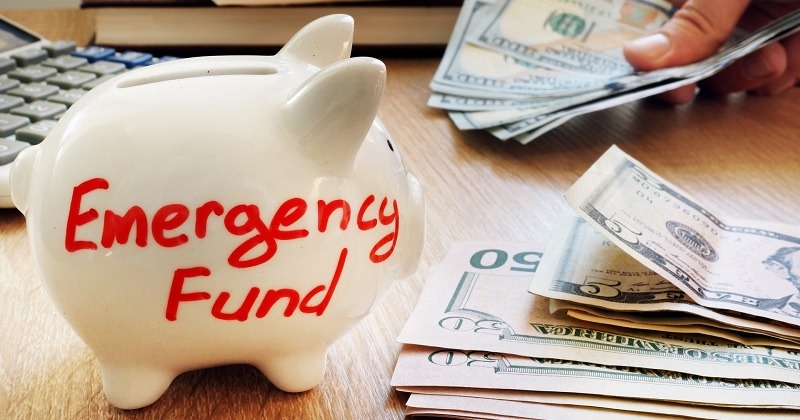
Have you ever found ind yourself in trouble like when your car breaks down or when you miss a week of work and you need to find money to cover the costs as soon as possible? Instead of relying on credit cards or short term loans, you can just access your emergency fund.
Whether you need a few hundred dollars or several thousand, most people need to have a few extra bucks set aside for rainy days, but the important question is where do you put it? Continue reading below to see where should you put your emergency fund?
Checking Accounts
Your checking account is probably the first place you might be keeping your emergency fund. If you’re good with your money, you’ll probably leave yourself a little bit of a buffer in your checking account. That’s basically the beginning of your emergency fund.
But you shouldn’t keep a huge buffer in your checking account since you won’t be getting much in return. Banks should be paying you for your money, so if they’re not paying, you shouldn’t be rewarding them with more money. We recommend putting in a buffer of $500 in your checking account, you could do more or less; just make sure to keep whatever amount makes you comfortable.
In terms of which checking account to use, you want to make sure that whatever checking account you use has no fees. There are free checking account these days that there’s pretty much no excuse for any checking account to charge you a monthly fee.
Another option is to go to an online-only checking account, some of them are free and pay a nominal amount of interest. However, the only weakness with online-only banks is that it can be difficult to deposit cash.
Normal Savings Account
Normal savings account are usually offered by your regular brick and mortar bank. We do recommend to not use these types of savings account since they offer low-interest rates that’s not going to do much for your money. You might as well keep your money in your checking account, if you’re thinking about doing this.
Online High-Yield Savings Accounts
Online savings account would be a good option for you. You can enjoy superior online/mobile experience along with earning a higher APY rate. We are personally recommend:
With Ally Bank, they offer 1% interest which is the highest amount you can get from a mainstream bank. Then they allow you to link up to 20 external bank accounts, which is very important if we want to take advantage super high-yield savings accounts.
Moreover, the advantage with Capital One 360 is that it allows you to create multiple sub-accounts making it easier to sub-divide your cash savings.
Money Market Accounts
A money market account is another option if you’re interested in getting a better interest rate and you’d like to have check-writing capabilities. Money market accounts have some things in common with regular savings accounts in terms of limits on the number of withdrawals you can make each month and the extent to which they’re insured by the FDIC.
There some differences to keep in mind, money market account usually need a higher minimum deposit and you may pay a little more in fees.
Investment Accounts
Investing your emergency fund is more work than just opening up a super high yield savings account and if you’re going to get around 5% interest by investing your emergency fund, you’re going to be taking the risk of loss when there are already ways to get 5% interest risk-free.
No-Penalty CDs
Certificate of deposits, otherwise known as CDs, will offer you one of the best & secure way to get a return on your money when you invest it with your bank/credit union of choice. You put a set amount of money in the CD and at the end of the term, you get it back along with any interest that’s accrued.
In general, the best CD accounts will produce a highyer yield versus a traditional sasvings account, but you may face a penalty if you withdraw the cash early. There are banks that offer no-penalty options, but it’s something to consider if you don’t think you will be using your emergency fund anytime soon.
Mutual Funds
Mutual funds are generally considered to be less volatile than individual stocks and it’s easier to invest if you’re not familiar with the ins and outs of how the market works. Moving some of your emergency savings into a mutual fund or two allows you to keep the rest of your cash liquid while potentially seeing significant growth.
Roth IRA
Roth IRA is usually a tool of retirement planning, but in some cases it can also be used as an emergency fund. Starting 2019, you can put up to $6,000 in Roth or $7,000 if you’re age 50 and all contributions are made with after-tax dollars.
Those contributions limits are expected to remain the same for 2020. Please note that withdrawals made before age 59 1/2 are subject to a 10% penalty. If you withdraw only the amount you contributed, you won’t have to pay income taxes on your withdrawals.
If you’re already funding a retirement account through your employer and you have extra cash in your savings account, you can always use your Roth IRA as backup. Just take note of the 10% early withdrawal penalty and do the best you can to avoid it.
 |
 |
 |
Bottom Line
There are different options on where you can put your emergency fund, but there are going to be a number of factors to consider before you make your choice. So if you’re not sure which option would be the best for you, consider asking a financial advisor for help.
Furthermore, you can also check out the best savings accounts or the best CD rates for you to choose which accounts where you want to put your emergency fund. While you’re here on HMB, you can check out other bank promotions and credit card bonuses here.



Leave a Reply